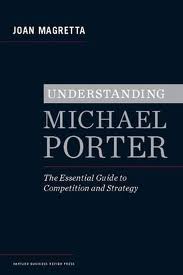Understanding Michael Porter: The Essential Guide to Competition and Strategy

– By Joan Magretta
There is absolutely no doubt that Michael Porter has been one of the most influential business thinkers and writers that we have known. His books include Competitive Strategy, Competitive Advantage, Competitive Advantage of Nations and On Competition. He has also written numerous articles that have been used and cited by many scholars and writers (and which have won critical acclaim). Yet, as Joan Magretta points out in her excellent book – Understanding Michael Porter – while every business executive has heard of Michael Porter, very few have taken the trouble to go through the immense amount of work that he has done since the 1980s or even tried to understand the crux of his thinking on competition and strategy.
Michael Porter is instrumental in introducing many important concepts that many of us would be familiar with. These include: `
- Competitive advantage
- Porter five forces analysis
- Strategic groups (also called strategic sets)
- The value chain
- The generic strategies of cost leadership, product differentiation, and focus
- The market positioning strategies of variety based, needs based, and access based market positions
- Global strategy
- Porter’s clusters of competence for regional economic development
- The Diamond model
- Porter’s four corners model
Magretta’s book is outstanding because she puts forward – very succinctly – some of the key concepts of Porter, the understanding of which would benefit business executives immensely. The book is divided into two parts – What is Competition? and What is Strategy?
In Part I, Magretta covers three key topics:
- Competition: The Right Mind-Set. Most business leaders feel that the essence of competition is ‘being the best’. However, that, while intuitive, is also destructive since it leads competing companies to keep bettering each other till the cost structure of the entire industry becomes unviable. The key to competition is being ‘unique’ because only by being different from the rest can a company provide sustained, superior performance.
- The Five Forces: Competing for Profits. Many of us would have used the Five Forces for our industry analysis. These five forces – the intensity of rivalry among existing competitors, the bargaining power of buyers (the industry’s customers), the bargaining power of suppliers, the threat of substitutes and the threat of new entrants – ‘explain the industry’s average prices and costs , and therefore the average industry profitability that you are trying to beat.’ The beauty of the Five Forces Framework – in contrast to the simplistic SWOT analysis that we all do – is that each of the five forces has a direct and predictable relationship with an industry’s profitability.
- Competitive Advantage: The Value Chain and Your P&L. According to Porter, competitive advantage is essentially about creating value in a unique way. This would imply that your value chain would be different from others in your industry which, in turn, would lead to superior performance and profitability.
Part II of the book – What is Strategy? – is really a summarisation of what, according to Porter, constitutes a good strategy. Simply put, a good strategy must pass five tests:
- A distinctive value proposition. Unfortunately, most executives feel that a distinctive value proposition is the strategy. However, a value proposition is outwardly directed at customers and is just the starting point of a strategy.
- A Tailored Value Chain. Once a value proposition has been determined, it is critical to perform the activities associated with the value proposition differently; that is, to create a differentiation in the supply side as well.
- Trade-offs different from rivals. ‘Competitive advantage depends on making choices that are different from those of rivals, on making trade-offs…Trade-offs are the strategic equivalent of a fork in the road. If you take one path, you cannot simultaneously take the other.’
- Fit across value chain. Being consistent right across the value chain is vital. So are activities that complement and reinforce each other. It is this synergy that would make the strategy robust and difficult to emulate.
- Continuity over time. Once you have embarked upon a strategic direction, it is important that there is stability in the core of the strategy. It is this stability that will ensure that you keep getting better at what you do.
The beauty of Magretta’s book – and why it is essential reading – is that it distils Porter’s ideas on competition and strategy and makes them accessible to all of us. And because the concepts are very important, all of us would only benefit from reading this book.
Rating: A+
